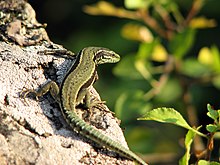From Wikipedia, the free encyclopedia
A claw is made of hard protein called keratin. Claws are used to catch and hold prey in carnivorous mammals such as cats and dogs, but may also be used for such purposes as digging, climbing trees, self-defense etc., in those and other species.
Similar appendages that are flat and do not come to a sharp point are called nails instead. Claw-like projections that do not form at the end of digits, but spring from other parts of the foot are properly named spurs.[1]
Claws of animals like tigers, lions, and bears were used in making items such as ornaments, pendants, and brooches. Tigers' and lions' claws are illegal to trade.
Contents
Arthropods
Main article: Chela (organ)
The correct term for an arthropod's "claw" is a chela (plural chelae). Legs bearing a chela are called chelipeds. Chelae are also called pincers.Tetrapods

At just under a meter, the claws of Therizinosaurus are among the largest recorded
Amphibians
The only amphibians to bear claws are the African clawed frogs. Claws appear to have evolved separately in the amphibian and amniote line.[2]Reptiles
Lizards, turtles and crocodylians
Lizard claws are used as aids in climbing, and in holding down prey in carnivorous species.
Birds
A talon is the claw of a bird of prey, its primary hunting tool.[4] The talons are very important; without them, most birds of prey would not be able to catch their food. Some birds also use claws for defensive purposes. Cassowaries use claws on their inner toe (digit II) for defence, and have been known to disembowel people. All birds however have claws, which are used as general holdfasts and protection for the tip of the digits.The hoatzin is unique among extant birds in having functional claws on the thumb and index finger (digit I and II) on the forelimbs as chicks, allowing them to climb trees until the adult plumage with flight feathers develop.[5] However, several birds have a claw- or nail-like structure hidden under the feathers at the end of the hand digits, notably ducks, geese and kiwis.[6]
Mammals
A nail is homologous to a claw but is flatter and has a curved edge instead of a point. A nail that is big enough to bear weight is called a 'hoof' (see also Horse hoof. However, one side of the cloven-hoof of artiodactyl ungulates may also be called a claw).Every so often, the growth of claws stops and restarts, as does hair. In hair, this results in the hair falling out and being replaced by a new one. In claws, this results in an abscission layer, and the old segment breaks off. This process takes several months for human thumbnails. Cats are often seen working old unguis layers off on wood or on boards made for the purpose. Ungulates' hooves wear or self-trim by ground contact. Domesticated equids (horses, donkeys and mules) usually need regular trimming by a farrier, as a consequence of reduced activity on hard ground.
Many predatory mammals have protractile claws that can partially hide inside the animal's paw, especially the Felidae, where almost all of its members have fully protractible claws.




No comments:
Post a Comment